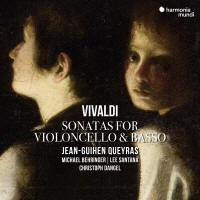Texte paru dans: / Appeared in: |
|
|
Outil de traduction (Très approximatif) |
|
|
Reviewer: Charlotte Gardner There’s a happy inevitability about French period cellists taking Vivaldi’s six cello sonatas into the recording studio, when the Bibliothèque Nationale de France still houses the manuscript copy used by unscrupulous Parisian publishers who first managed to publish the set in 1740, without Vivaldi’s permission. What Queyras has come up with here is very fine, too. Plus it’s satisfyingly different to Christophe Coin’s beautifully slender-toned 1989 effort with Christopher Hogwood. If you wanted one takeaway headline for this recording then it would be its sense of intimacy and immediacy; a quality we can mostly put down to the easy, loving familiarity with which Queyras handles this repertoire, but one which has also been heightened by his surrounding decision-making. For instance, while these days Queyras’s usual cello is a 1696 instrument by the Turinese maker Gioffredo Cappa, for this Vivaldi he’s returned to the intimate and soft-timbred anonymous Milanese cello of 1690 you hear on past recordings such as the Haydn concertos (10/04) and the Britten Suites (1/99). He’s then strung this with plain gut (rather than wound), and the slightly thicker girth of the strings has brought a lovely rounded warmth and textural catch to his sound. Finally there’s the engineering, which places him relatively far forwards in the balance; but don’t be put off by the intake of breath you hear in the first few seconds of the opening No 5 in E minor, because that’s not a running theme. Another nice touch is the way his continuo forces vary between sonatas, and sometimes within the same one. Take No 4 in B flat, which uses dulcet-toned organ in the first and second movements but in the third drops it for theorbo; this is followed by No 2 in F major, for which it’s the harpsichord that fluidly dances in. If you’re in the market for a top period performance and want to do some comparative listening before taking the plunge, then I’d suggest either that Coin recording or the one from Marco Ceccato with Accademia Ottoboni. However, either way, you won’t go wrong with this new recording. |
|




